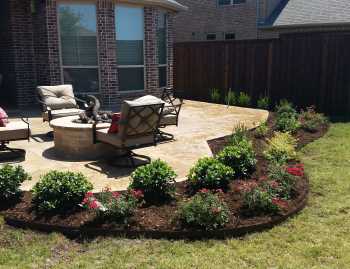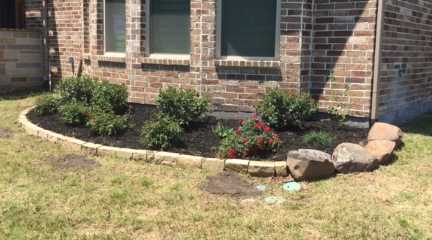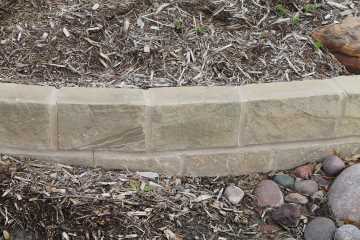
As a landscaping company, we get calls every day from customers. For every one call we receive from a customer wanting to create a new flower bed, we receive another two calls to clean grass out of the bed. A customer may invest thousands of dollars to create a beautiful landscape, but it’s only a matter of time before the grass takes over. The question we answer every day is, “How do I keep the grass from trying to get into my flower bed?” The answer is…YOU CAN’T!
Most all turf grasses grow on runners several inches beneath the soil line, so unless you are willing to eliminate your beautiful lawn or install a solid barrier beneath the ground, the grass will continue to invade. There are, however, several tried and tested methods you can employ to stem the tide.
Method #1: Hand Pulling
This is the easiest and most cost-effective solution to keeping grass out of your flower bed. In the DFW area, the growing season for most grasses is between March and November. You should plan to spend a little time each week pulling the grass out by hand.
PRO: It’s inexpensive and easy to do.
CON: Other than the obvious labor and time involved, hand pulling only solves the problem temporarily. In addition, have you ever tried to pull a blade of grass out by the roots? It’s almost impossible as the blades are so fine; they simply rip off, leaving the root intact.
Method #2: Grass Killer
If you look in the garden section of any hardware store, the shelves are lined with various chemical options to eliminate grass and weeds. They are simple to use, just point the bottle at the offending grass and spray. The grass is killed down to the root. Until recently, the most common remedy for the average home owner was RoundUp. RoundUp is a nonselective (meaning that it doesn’t target something specific) herbicide. However, in 1995, the International Cancer Agency found that glyphosate, the active ingredient in most herbicides, is a known carcinogen (cancer causing) 1. Since then, many people have looked for a more natural alternative. Something as simple as vinegar can effectively eliminate grass and weeds. Other natural options at your hardware store might simply burn the grass as opposed to eliminating it at the root.
PRO: Grass killers are inexpensive and readily available.
CON: Many common grass killers contain glyphosate which is a known carcinogen. In addition, most herbicides are nonselective, which means that it will kill all plants it comes in contact with. So you can kill the grass, but if it happens to land on a nearby plant, it’s going to perish as well. Organic grass killers, such as vinegar, are nonselective as well.
Method #3: Mulch
By nature, most all plants are attracted to sunlight and they will naturally grow in that direction. Keeping your flower beds topped with between 2-3 inches of mulch at all times will create a shady barrier in your bed and discourage grass from invading.
PRO: Mulch is readily available and reasonably inexpensive. On average, a 2 cubic ft bag of hardwood mulch is $3.50. The other “upside” of the mulching method is that it happens to be the very best way to encourage proper watering for your plants. Mulch eliminates much of the natural water evaporation so that more of your water goes directly to the plant.
CON: Mulching is an ongoing cost. Most mulch will start to break down after about 8-10 months. We would recommend replacing or refreshing your mulch each year. For customers with multiple flower beds, the cost can really add up. Mulching is also not a guarantee that grass won’t grow in your beds, but only a deterrent.
Method #4: Landscape Fabric
Available at any local hardware store or nursery, landscape fabric, or weed barrier is usually a black, breathable material that can be installed using a scissors and large staples. The ideal time to install landscape fabric would be before any plants are installed. You simply cut out the length you need to cover your flower bed with a scissors. While installing, make sure to overlap the strips and allow for a few extra inches on the ends. Once you have covered the entire landscape bed, push the large staples through the fabric and into the ground every couple of feet, especially around the edges of the flower bed. As you plant, you will need to cut a hole in the fabric to accommodate. If you have drip line irrigation, these lines should be placed on top of the fabric to allow easy access.
PRO: Landscape fabric is relatively inexpensive and easy to install. The fabric is a more effective barrier to sunlight and acts as a physical barrier preventing the grass from penetrating.
CON: The very big drawback to using landscaping fabric is that it’s only effective if there are no holes in the fabric. Unfortunately, every time you cut a hole to install a plant, you break the barrier. Imagine if you wanted to plant 20-60 annuals towards the front of your flower bed, think again! You can cut the holes, but have now given your grass 20-60 new options for arriving into your flower bed.
Method #5: Edging
A very common and aesthetically pleasing option would be to install an edging around the perimeter of your flower bed. Some common examples would be: steel, boulder stone, chopped stone edging. Steel edging is available in green, brown and black and comes in both 4 and 6 inch heights. The steel edging comes with spikes on the bottom side that you can easily pound into the ground to secure. You can also find a large selection of boulder and chopped stones at your local stone yard. The cost for steel edging is about $1.50 per ft while the natural stone climbs a bit higher to about $3.00 per ft, but can vary depending on the stone.
PRO: Edging can add a natural beauty to your flower bed. Having any kind of edging in place will keep the soil and mulch inside the bed. In addition, the edging will act as a partial barrier, discouraging grass from growing into your flower bed.
CON: Depending on the edging material, it may take hiring a professional to install, which adds to the cost. While the stone is simply heavy and will take some digging to set it in place, the steel edging will likely need to be cut with a hacksaw to custom-fit the edges of your flower bed. Since grass grows on runners several inches beneath the soil line, these edging options do not create a total barrier to fully prevent the grass growth. In addition, if you are placing stones along your perimeter, the natural gap between the stones is still enough room for the grass to find a way into your flower bed.
Method #6: Mortared Stone Edging
A mortared stone edging uses natural stone or brick to create a solid stone wall along the perimeter of your flower bed. For any mortared wall, we recommend pouring a concrete footer 6-8 inches below the soil line. Your concrete footer should be 3-4 inches deep and be reinforced with rebar. After the concrete footer has set, secure your stones to the footer and each other using mortar.
PRO: Because it creates a solid, concrete barrier several inches beneath the soil line, grass is unable to penetrate into the flower bed. It will keep soil and mulch from spilling out of the bed. Finally, a well-constructed mortared stone edging can be a true landscape feature, adding incredible beauty and value to your home.
CON: The process to create a mortared stone edging is labor-intensive and time-consuming. Most people would opt to have a professional complete the installation and it can be pricy. Most reputable landscaping companies or masons would charge between $30 and $60 per linear ft, depending on the stone selection and how high the edging will go.
There is no shortage of available options to try and discourage grass from coming into your flower beds. For someone on a budget, we would recommend hand pulling along with keeping a healthy layer of mulch in your beds. For those who are short on time and willing to invest some money in their landscaping, a mortared stone edging would be the best way to go.
- Beyond Pesticides, Washington DC, March 20, 2015 “Glyphosate Classified Carcinogenic by International Cancer Agency, Group Calls on U.S. to End Herbicide’s Use and Advanced Alternatives”, accessed May 23, 2018, https://beyondpesticides.org/dailynewsblog/2015/03/glyphosate-classified-carcinogenic-by-international-cancer-agency-group-calls-on-u-s-to-end-herbicides-use-and-advance-alternatives/






